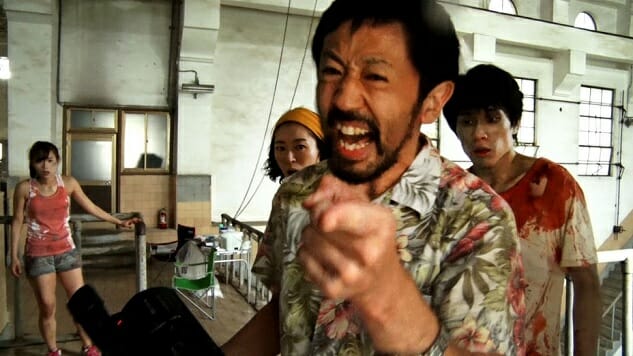
Director Higurashi (Takayuki Hamatsu), beleaguered protagonist of Shinichiro Ueda’s box office indie smash One Cut of the Dead, has two modes: “On” and “in dire need of an ‘off’ button.” Even at his most sedate, Higurashi hums with the unharnessed energy of a pent-up greyhound, always at the ready for a race around the track but conditioned to patiently wait until the signal is given. Once it is, he’s a sight to behold, a man unleashed, screaming like a maniac christened as dictator, vaulting around sets with such vigor and dexterity to put the world’s parkour champions to shame. Hamatsu’s is the kind of performance that can only be contained by a specific kind of film.
That film is One Cut of the Dead. Ueda first introduces Higurashi as a despotic indie filmmaker howling at his weeping star, Chinatsu (Yuzuki Akiyama), then 37 minutes later reveals the man to be a docile, much too obliging videographer who chiefly works on weddings and karaoke clips. It’s a glorious, bonkers 37 minutes, too, presented as a zombie movie shoot gone wrong. Higurashi and his cast—Chinatsu, former actress (and Higurashi’s wife) Nao (Harumi Shuhama), and pain in the ass leading man Ko (Kazuaki Nagaya)—and crew have set up shop at a decrepit, isolated warehouse that also stores a coterie of shambling undead. As they’re besieged by ghouls, Higurashi, yet to find a take that he actually likes, keeps on filming through the carnage.
Of course it’s all a film-within-a-film. The director’s been hired (read: strong-armed) to direct a one-take, live-broadcast zombie flick for a horror TV channel on the strength of his personal slogan—fast, average and cheap. The first and third of these prove true, but the second turns out to be a bullshit lie he tells himself. Once One Cut of the Dead shifts gears from a zombie movie to a backstage inside baseball comedy, the initially cold atmosphere Ueda establishes warms up. The amateur terror of Higurashi’s guerilla filmmaking gives way to winning charms as the audience gets to see who he really is, what this project means to him and just how damn hard it is to make a movie in a single take.
Frankly, One Cut of the Dead proves just how damn hard it is to make a movie, period, but it’s able to make an even more profound point: Film is a communal experience on either side, making and watching. Skepticism abounds amongst Higurashi’s cast, his crew (similarly comprising a bunch of sniffly, difficult-to-work-with types) and even his family (particularly his daughter, Mao, played by mononymous pop star Mao). Granted, the very concept of a one-take zombie film sounds terrible on paper. In fact, that’s why the network chooses Higurashi for the job—no one else would take it, wise to the utter embarrassing futility of the task. But Higurashi wants to hang his hat on more than hack work. He wants to make art. He wants to win the respect of his daughter. Most of all he wants to win some dignity.
No part of production goes off without a hitch—the sound guy has a tummy so sensitive that drinking the wrong brand of water precipitates an intestinal maelstrom; neither the makeup artist nor the actor originally hired to play the tyrant filmmaker end up making it to the set; one of the auxiliary guys is a lousy drunk. That’s the pleasure of the film: watching everyone work tirelessly, with seconds to spare, to keep the shoot on target. Even better, Ueda, after opening on the final product of the team’s efforts, pulls back to give the audience another view of the production in action. Crew members hide off camera with fake blood and dummy corpses at the ready, or brandishing placards with written instructions for reacting to the endless speedbumps obstructing a smooth shoot, and Higurashi dashes around to pop out of nowhere barking “action” as mayhem unfolds around him.
It’s chaos, but it’s controlled chaos (even if only just), and in the chaos there’s absolute joy. One Cut of the Dead ends with smiles, pride, reconciliations and the accomplished sense of having achieved the impossible. If that’s not a ringing endorsement of collaborative art’s benefits, then what is? Maybe Ueda’s film is an odd messenger for delivering such high sentiment, but it’s the messenger we have, and we should embrace it.
Director: Shinichiro Ueda
Writer: Shinichiro Ueda, Ryoichi Wada
Starring: Takayuki Hamatsu, Harumi Shuhama, Mao, Yuzuki Akiyama, Kazuaki Nagaya
Release Date: September 13, 2019 (limited engagements in theaters; premiering soon on Shudder)
Boston-based culture writer Andy Crump has been writing about film and television online since 2009 (and music since 2018). You can follow him on Twitter and find his collected writing at his personal blog. He is composed of roughly 65% craft beer.